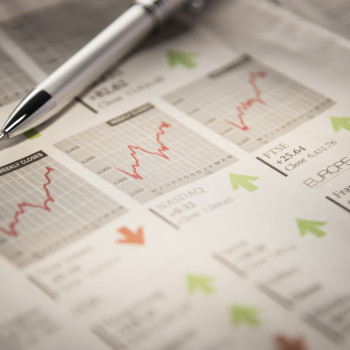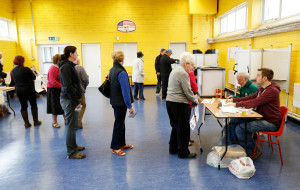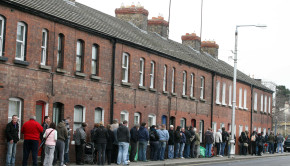Can government keep feel-good factor going to win voters?

Falling unemployment, rising tax revenues and a growing economy. The government has managed, whether by accident or design, to align the economic and electoral cycles. But will the gradual economic recovery be sufficient to generate a “feel good” factor in advance of the next general election, asks Dan White
11 March 2015
We are now in the countdown to the next general election. The last general election took place on February 25, 2011. It is widely believed that a general election must be held within five years of the last general election, i.e. by February 25, 2016. Not quite.
In fact Article 16 of the Constitution allows up to seven years between general elections. Even within the existing five-year electoral cycle, the dissolution of the outgoing Dail can be delayed until the fifth anniversary of when it first met rather than when it was first elected. This means that the last possible date for the dissolution of the 31st Dail is March 9, 2016. With another 30 days allowed until polling the next general election could, theoretically at least, be postponed until April 8, 2016. Throw in the further 30 days allowed between the general election and the first meeting of the new Dail and the coalition could conceivably cling to office until May 8, 2016.
Play it long
With all of the economic indicators turning positive but the polling data still deep into negative territory the coalition will be tempted to play it long. The ongoing Greek crisis shows no signs of abating and the far-left Podemos party, a sort of Syriza squared, looks set to win next autumn’s Spanish general election. This almost certainly means that our European masters will be far more inclined to tolerate a minor outbreak of Irish fiscal recidivism, so stand by for a pre-election giveaway budget in October.
On the face of it the economic numbers now coming through should make next year’s general election a walk in the park for the coalition. The economy is now growing strongly with the ESRI estimating that Irish GNP (by far the best indicator of the performance of the domestic economy) rose by 4.9% in 2014 with a 5.2% increase being forecast for 2015. Not quite up to the heady growth rates achieved during the credit-fuelled Celtic Tiger bubble era, but still the highest growth rates in the EU.

On polling day will voters reward the coalition for rescuing the economy from its post-2007 collapse or astound it with their ingratitude?
Falling unemployment
Even better news for the government is that this renewed economic growth is producing tangible results that voters can relate to. The live register total of people signing on in February, a seasonally-adjusted 355,000 was 43,000 lower than it was in February 2014 and brings the unemployment rate down to 10.1%. This almost certainly means that the unemployment rate will be well under 10% come polling day.
Lower unemployment is one of the main drivers behind the recovery in the public finances with 2014 tax revenues coming in €1.24bn ahead of target. The strong growth in tax revenues continued into the New Year with revenue in the first two months of 2015 being €345m ahead of target. Consumer confidence is also on the rise with the KBC Bank/ESRI consumer confidence index hitting its highest level for nine years in January.
This in turn is feeding through into higher retail sales with the value of retail sales rising by 4.1% in 2014. Even when volatile car sales are excluded the value of retail sales rose by 1.6%. Hardly earth-shattering but after their catastrophic post-2007 collapse, when the value of retail sales fell by over a quarter, it’s a welcome sign that the worst may be over for the country’s battered retailers. This increase in the value of retail sales seems to have continued into 2015 with the value of non-motor retail sales rising once again in January.
Wages not rising fast enough
The problem for the government is that for every positive economic indicator there seems to be a matching negative number. Yes, the Irish economy is creating large numbers of new jobs once again but this is taking forever to translate into higher wages. The latest earnings data from the CSO show that, while average earnings rose by 2.3% in the year to the final quarter of 2014, this was the first annual increase to be recorded since 2007.
It will take at least another year before rising wages start to generate a “feel good” factor. The good news for the coalition is that employers’ body IBEC is forecasting that 60% of companies will increase the wages which they pay to their workers this year, with the average predicted increase being 2%. To which a cynic might respond, that if IBEC is publicly conceding a 2% increase in wages for 2015, then the actual increase will almost certainly be considerably higher.
Until this trend of rising wages becomes firmly established consumer confidence will remain fragile. This can be seen by the sharp monthly fall in consumer confidence recorded in October in the wake of the anti-water charges protests.
House prices fragile
Another concern has got to be the clear signs that the house price recovery may have run its course. Average house prices fell by 1.4% in January having been virtually static in November and December. While the proximate cause of the stalling in house prices was almost certainly the publication in October by the Central Bank of new mortgage lending rules, which imposed tough new income limits and deposit requirements on borrowers, the truth is that the house price recovery always had a very fragile look about it.
Transaction volumes and new mortgage lending remain at minuscule levels with a mere 35,000 houses and apartments out of a total of almost 2 million changing hands in 2014. While new mortgage lending of €3.9bn in 2014 was up almost 60% on the €2.5bn of new mortgage lending in 2013, it was still less than 10% of the more than €40bn of new mortgage lending in the peak year of 2006.
Government relying on feel-good factor
It is the ambivalent nature of much of the economic data that is almost certainly to blame for the coalition’s persistent lack of popularity with voters. The latest IPSO MRBI/Irish Times poll puts the two government parties on a combined 25% share of the electorate. By pushing polling day to the very last minute the government will be hoping that the continuing flow of good economic news will create the “feel good” factor that has been lacking up to now.
On polling day will voters reward the coalition for rescuing the economy from its post-2007 collapse or astound it with their ingratitude? Fine Gael and Labour are entitled to hope for the former outcome but would be well-advised to prepare for the latter.



 Print
Print




Fans 0
Followers